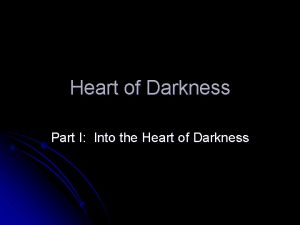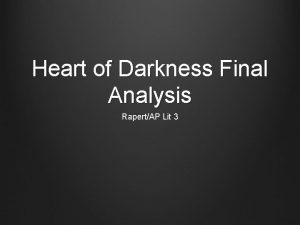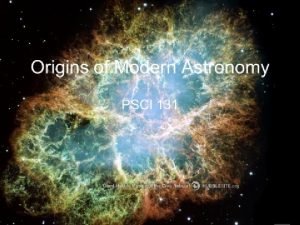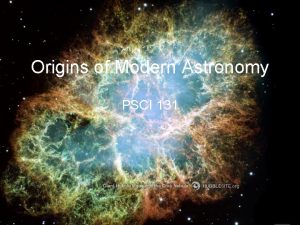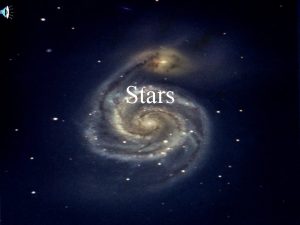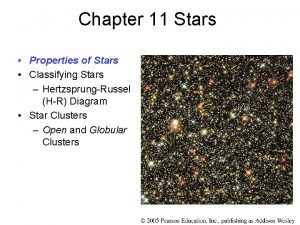PSCI 1414 GENERAL ASTRONOMY THE DEATHS OF STARS













































- Slides: 45

PSCI 1414 GENERAL ASTRONOMY THE DEATHS OF STARS PART 1: A SECOND RED GIANT PHASE, PLANETARY NEBULA, AND WHITE DWARFS ALEXANDER C. SPAHN

THE DEATHS OF STARS When a star of 0. 4 solar mass or more reaches the end of its main-sequence lifetime and becomes a red giant, it has a compressed core and a bloated atmosphere. Finally, the star devours its remaining nuclear fuel and begins to die. As we will learn in this chapter, the character of the star’s death depends crucially on the value of its mass.

THE RED GIANT AND HORIZONTAL-BRANCH STAGES Let’s examine what happens next for a star of moderately low mass, between 0. 4 and 4 M ⊙. One example for such a star is our own Sun, with a mass of 1 M⊙. Recall that we can describe a star’s post–main-sequence evolution using an evolutionary track on a H-R diagram.

THE RED GIANT AND HORIZONTAL-BRANCH STAGES This figure shows the track for a 1 -M⊙ star like the Sun. Once core hydrogen fusion ceases, the core shrinks, heating the nearby surrounding hydrogen and triggering shell hydrogen fusion. The new outpouring of energy causes the star’s outer layers to expand cool, and the star becomes a red giant. As the luminosity increases and the surface temperature drops, the post–main-sequence star moves up and to the right along the red giant branch on an H-R diagram.

THE RED GIANT AND HORIZONTAL-BRANCH STAGES Next, the helium-rich core of the star shrinks and heats until eventually core helium fusion begins. This second post–main-sequence stage begins gradually in stars more massive than about 2– 3 M⊙, but for less massive stars it comes suddenly—in a helium flash.

THE RED GIANT AND HORIZONTAL-BRANCH STAGES The core expands when core helium fusion begins, which makes the core cool down a bit. The cooling of the core also cools the surrounding hydrogen -fusing shell, so that the shell releases energy more slowly. Hence, the luminosity goes down a bit after core helium fusion begins.

THE RED GIANT AND HORIZONTAL-BRANCH STAGES The slower rate of energy release also lets the star’s outer layers contract. As they contract, they heat up, so the star’s surface temperature increases and its evolutionary track moves to the left on the H-R diagram. The luminosity changes relatively little during this stage, so the evolutionary track moves almost horizontally, along a path called the horizontal branch.

AGB STARS: THE SECOND RED GIANT STAGE After about a hundred million years of core helium fusion, essentially all the helium in the core of a 1 -M⊙ star has been converted into carbon and oxygen, and the fusion of helium in the core ceases. Without nuclear reactions to maintain the core’s internal pressure, the core again contracts, until it is stopped by degenerate electron pressure. This contraction releases heat into the surrounding heliumrich gases, and a new stage of helium fusion begins in a thin shell around the core in what is called shell helium fusion.

AGB STARS: THE SECOND RED GIANT STAGE History now repeats itself—the star enters a second red giant phase. A star first becomes a red giant at the end of its mainsequence lifetime, when the outpouring of energy from shell hydrogen fusion makes the star’s outer layers expand cool. In the same way, the outpouring of energy from shell helium fusion causes the outer layers to expand again.

AGB STARS: THE SECOND RED GIANT STAGE When a low-mass star becomes an AGB star, it consists of a carbon-oxygen core (supported by degenerate electron pressure) with no nuclear reactions, and a helium-fusing shell, both inside a dormant shell of hydrogen that is too cool for fusion to take place.

CONVECTION, DREDGE-UPS, AND CARBON STARS The first dredge-up takes place after core hydrogen fusion stops, when the star becomes a red giant for the first time. Convection dips so deeply into the star that material processed by the CNO cycle of hydrogen fusion is carried up to the star’s surface, changing the relative abundances of carbon, nitrogen, and oxygen. A second dredge–up occurs after core helium fusion ceases, further altering the abundances of carbon, nitrogen, and oxygen.

CONVECTION, DREDGE-UPS, AND CARBON STARS Still later, during the AGB stage, a third dredge–up can occur if the star has a mass greater than about 2 M⊙. This third dredge–up transports large amounts of freshly synthesized carbon to the star’s surface, and the star’s spectrum thus exhibits prominent absorption bands of carbon–rich molecules like C 2, CH, and CN. For this reason, an AGB star that has undergone a third dredge-up is called a carbon star.

CONVECTION, DREDGE-UPS, AND CARBON STARS All AGB stars have very strong stellar winds that cause them to lose mass at very high rates. Carbon stars are important because they enrich the interstellar medium with carbon and some nitrogen and oxygen.

THE DEEP STUFF (YOU REALLY ARE “STAR STUFF”) The triple alpha process that occurs in helium fusion is the only way that carbon can be made, and carbon stars are the primary avenue by which this element is dispersed into interstellar space. Indeed, most of the carbon in your body was produced long ago inside a star by the triple alpha process. This carbon was later dredged up to the star’s surface and ejected into space. Some 4. 56 billion years ago a clump of the interstellar medium that contained this carbon coalesced into the solar nebula from which our Earth—and all of the life on it—eventually formed. In this sense you can think of your body as containing “recycled” material—substances that were once in the heart of a star that formed and evolved long before our solar system existed.

PLANETARY NEBULAE For a star with a moderately low mass (between 0. 4 and 4 M⊙), the AGB stage in its evolution is a dramatic turning point. Before this stage, a star loses mass only gradually through steady stellar winds. But as it evolves during its AGB stage, a star divests itself completely of its outer layers.

PLANETARY NEBULAE The aging star undergoes a series of bursts in luminosity, and in each burst it ejects a shell of material into space. Eventually, all that remains of a low-mass star is a fiercely hot, exposed core, surrounded by glowing shells of ejected gas. This late stage in the life of a star is called a planetary nebula.

MAKING A PLANETARY NEBULA To understand how an AGB star can eject its outer layers in shells, consider the internal structure of such a star. As the helium in the helium-fusing shell is used up, the pressure that holds up the dormant hydrogen-fusing shell decreases. Hence, the dormant hydrogen shell contracts and heats up, and hydrogen fusion begins anew.

MAKING A PLANETARY NEBULA This revitalized hydrogen fusion creates helium, which rains downward onto the temporarily dormant helium-fusing shell. As the helium shell gains mass, it shrinks and heats up. When the temperature of the helium shell reaches a certain critical value, it reignites in a helium shell flash that is similar to (but less intense than) the helium flash that occurred earlier in the evolution of a low-mass star.

MAKING A PLANETARY NEBULA The released energy pushes the hydrogen-fusing shell outward, making it cool off, so that hydrogen fusion ceases and this shell again becomes dormant. The process then starts over again. When a helium shell flash occurs, the luminosity of an AGB star increases substantially in a relatively short-lived burst called a thermal pulse.


MAKING A PLANETARY NEBULA During these thermal pulses, the dying star’s outer layers can separate completely from its carbon-oxygen core. As the ejected material expands into space, dust grains condense out of the cooling gases. Radiation pressure from the star’s hot, burned-out core acts on the specks of dust, propelling them further outward, and the star sheds its outer layers altogether. In this way an aging 1 -M⊙ star loses as much as 40% of its mass. More massive stars eject even greater fractions of their original mass.

MAKING A PLANETARY NEBULA As a dying star ejects its outer layers, the star’s hot core becomes exposed. With a surface temperature of about 100, 000 K, this exposed core emits ultraviolet radiation intense enough to ionize and excite atoms in the expanding shell of ejected gases. These gases therefore glow and emit visible light through the process of fluorescence.




THE PROPERTIES OF PLANETARY NEBULAE Planetary nebulae are quite common. Astronomers estimate that there are 20, 000 to 50, 000 planetary nebulae in our Galaxy alone. Many planetary nebulae are more or less spherical in shape. This shape is a result of the symmetrical way in which the gases were ejected. But if the rate of expansion is not the same in all directions, the resulting nebula can take on an hourglass or dumbbell appearance.

THE PROPERTIES OF PLANETARY NEBULAE

WHITE DWARFS We have seen that after a moderately low-mass star (from about 0. 4 to about 4 solar masses) consumes all the hydrogen in its core, it is able to ignite nuclear reactions that convert helium to carbon and oxygen. Given sufficiently high temperature and pressure, carbon and oxygen can also undergo fusion reactions that release energy. But for such a moderately low-mass star, the core temperature and pressure never reach the extremely high values needed for these reactions to take place.

WHITE DWARFS Instead, as we have seen, the process of mass ejection just strips away the star’s outer layers and leaves behind the hot carbonoxygen core. With no nuclear reactions taking place, the core simply cools down like a dying ember. This burned-out relic of a star’s former glory is called a white dwarf. Such white dwarfs prove to have exotic physical properties that are wholly unlike any object found on Earth.

PROPERTIES OF WHITE DWARFS A cooling white dwarf maintains its size because the burned-out stellar core is so dense that most of its electrons are degenerate. Thus, degenerate electron pressure supports the star against further collapse. This pressure does not depend on temperature, so it continues to hold up the star even as the white dwarf cools and its temperature drops.

PROPERTIES OF WHITE DWARFS Observations of white dwarfs in binary systems like Sirius allow astronomers to determine the mass, radius, and density of these stars. Such observations show that the density of the degenerate matter in a white dwarf is typically 109 kg/m 3 (a million times denser than water). A teaspoonful of white dwarf matter brought to Earth would weigh nearly 5. 5 tons—as much as an elephant!

THE MASS-RADIUS RELATION FOR WHITE DWARFS Degenerate matter has a very different relationship between its pressure, density, and temperature than that of ordinary gases. Consequently, white dwarf stars have an unusual mass-radius relation: The more massive a white dwarf star, the smaller it is.

THE MASS-RADIUS RELATION FOR WHITE DWARFS However, there is a limit to how much pressure degenerate electrons can produce. As a result, there is an upper limit to the mass that a white dwarf can have. This maximum mass is called the Chandrasekhar limit. The Chandrasekhar limit is equal to 1. 4 M⊙, meaning that all white dwarfs must have masses less than 1. 4 M⊙. As we will see soon, when the Chandrasekhar limit is exceeded, the star is no longer a white dwarf, and the results are explosive.

LIKE DIAMONDS IN THE SKY The material inside a white dwarf consists mostly of ionized carbon and oxygen atoms floating in a sea of degenerate electrons. About 5 × 109 years after the star first becomes a white dwarf, when its luminosity has dropped to about 10− 4 L⊙ and its surface temperature is a mere 4000 K, the ions no longer move freely. Instead, they arrange themselves in orderly rows, like an immense crystal lattice. From this time on, you could say that the star is “solid. ” A diamond is also crystalline (with carbon ordered in a crystal lattice), so a cool carbon-oxygen white dwarf has some similarities to a giant diamond in the sky!

FROM GIANT TO PLANETARY NEBULA TO WHITE DWARF This figure shows the evolutionary tracks for three burned-out stellar cores as they pass through the planetary nebula stage and become white dwarfs. When these three stars were red giants, they had masses of 0. 8, 1. 5, and 3. 0 M⊙. Mass ejection strips these dying stars of up to 60% of their matter.

FROM GIANT TO PLANETARY NEBULA TO WHITE DWARF During their final spasms, the luminosity and surface temperature of these stars change quite rapidly. The points representing these stars on an H-R diagram race along their evolutionary tracks, sometimes executing loops corresponding to thermal pulses. Finally, as the ejected nebulae fade and the stellar cores cool, the evolutionary tracks of these dying stars take a sharp turn toward the white dwarf region of the H-R diagram.









FOR NEXT TIME… • Read second half of Chapter 20 • Homework 24: Chapter 20 questions 1, 3, 5, 10, 13, 14, 16 (Due Wednesday, April 27)
 Jeremias 1414 falsos profetas
Jeremias 1414 falsos profetas Learning astronomy by doing astronomy activity 1 answers
Learning astronomy by doing astronomy activity 1 answers Learning astronomy by doing astronomy activity 7 answers
Learning astronomy by doing astronomy activity 7 answers Learning astronomy by doing astronomy activity 1 answers
Learning astronomy by doing astronomy activity 1 answers There are three sizes of schnauzer dog
There are three sizes of schnauzer dog Psci audit
Psci audit Pharmaceutical supply chain initiative psci
Pharmaceutical supply chain initiative psci Pharmaceutical supply chain initiative
Pharmaceutical supply chain initiative World million deaths
World million deaths Bulimia cheeks before after
Bulimia cheeks before after Crystal ballroom millennium biltmore hotel
Crystal ballroom millennium biltmore hotel Who fought in ww2
Who fought in ww2 Lincoln interpreted his reelection as a mandate to
Lincoln interpreted his reelection as a mandate to Tasmania births deaths and marriages
Tasmania births deaths and marriages Deaths from smoking
Deaths from smoking The heart of darkness summary
The heart of darkness summary 2020 motor vehicle deaths
2020 motor vehicle deaths Menengai crater fire
Menengai crater fire Clydebank blitz map
Clydebank blitz map Heart of darkness part 3 quotes
Heart of darkness part 3 quotes West point graduate deaths
West point graduate deaths Tobacco causes _______ of cancer deaths around the world. *
Tobacco causes _______ of cancer deaths around the world. * Dr abeer deaths
Dr abeer deaths Lời thề hippocrates
Lời thề hippocrates Khi nào hổ mẹ dạy hổ con săn mồi
Khi nào hổ mẹ dạy hổ con săn mồi đại từ thay thế
đại từ thay thế Quá trình desamine hóa có thể tạo ra
Quá trình desamine hóa có thể tạo ra Công của trọng lực
Công của trọng lực Thế nào là mạng điện lắp đặt kiểu nổi
Thế nào là mạng điện lắp đặt kiểu nổi Hát kết hợp bộ gõ cơ thể
Hát kết hợp bộ gõ cơ thể Dạng đột biến một nhiễm là
Dạng đột biến một nhiễm là Vẽ hình chiếu đứng bằng cạnh của vật thể
Vẽ hình chiếu đứng bằng cạnh của vật thể Biện pháp chống mỏi cơ
Biện pháp chống mỏi cơ Phản ứng thế ankan
Phản ứng thế ankan Gấu đi như thế nào
Gấu đi như thế nào Kể tên các môn thể thao
Kể tên các môn thể thao Khi nào hổ mẹ dạy hổ con săn mồi
Khi nào hổ mẹ dạy hổ con săn mồi Thiếu nhi thế giới liên hoan
Thiếu nhi thế giới liên hoan điện thế nghỉ
điện thế nghỉ Một số thể thơ truyền thống
Một số thể thơ truyền thống Trời xanh đây là của chúng ta thể thơ
Trời xanh đây là của chúng ta thể thơ So nguyen to
So nguyen to Phối cảnh
Phối cảnh Các châu lục và đại dương trên thế giới
Các châu lục và đại dương trên thế giới Tư thế worms-breton
Tư thế worms-breton















